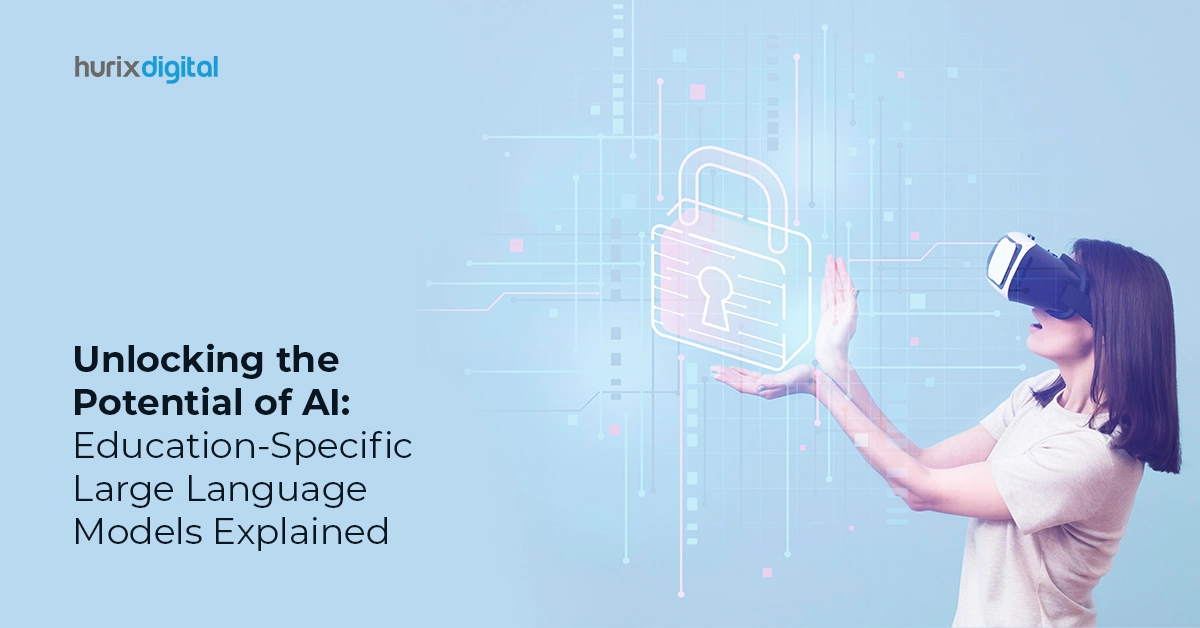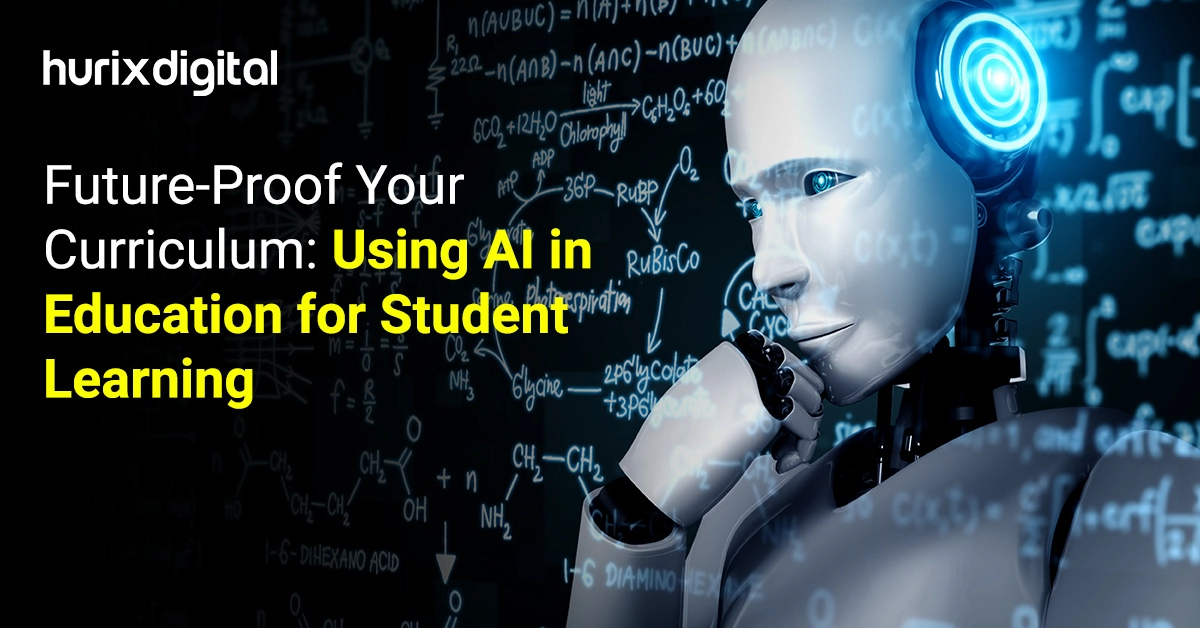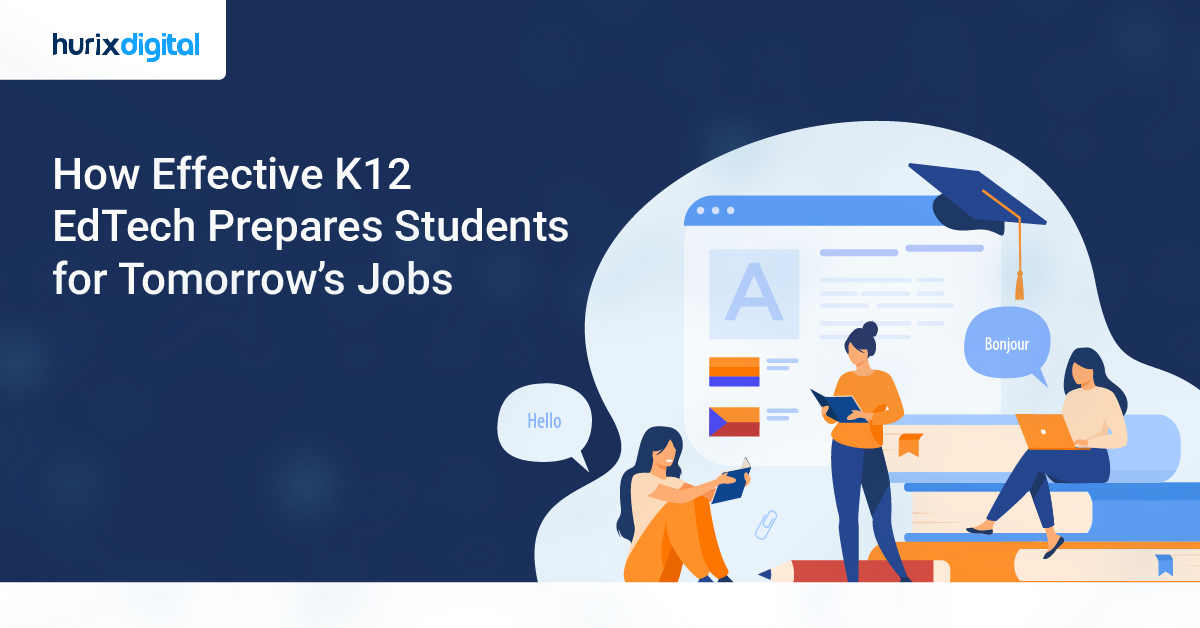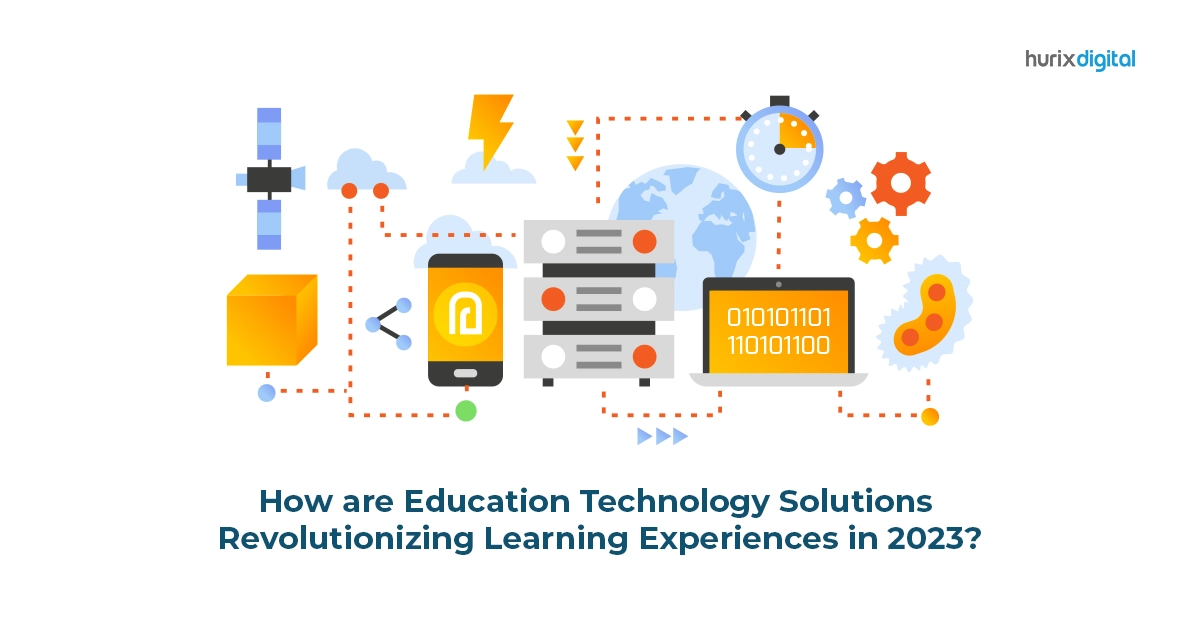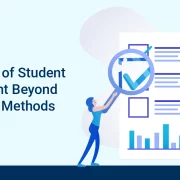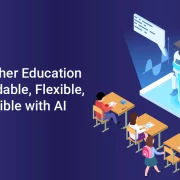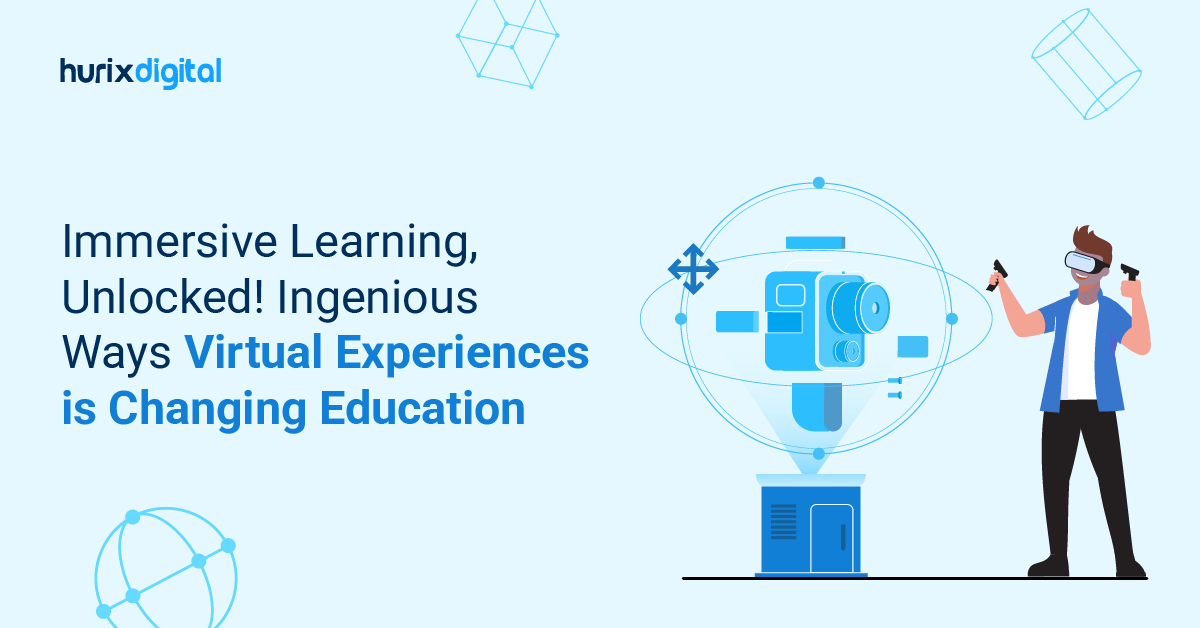
Immersive Learning, Unlocked! Ingenious Ways Virtual Experiences is Changing Education
The concept of immersive learning has changed vastly over the past couple of years. What used to consist of field trips to the zoo, a monument, the courts, or a museum is today being replaced by technology.
Gone are the days when learning in a classroom merely involved a teacher or a professor standing in front of a class and reading out a textbook all day long. Today, education technology such as Artificial Intelligence (AI), Machine Learning (ML), and Virtual Reality (VR) have made day-to-day learning a lot more immersive and engaging.
What benefits does immersive learning, as we know it today, offer students and teachers? How can including AR education and VR education in curriculums prepare students for the future?
As per Forbes, it matters a lot. Learning through immersive experiences can increase knowledge retention by as much as 75%. This highlights the significant impact of immersive learning on knowledge retention and overall educational effectiveness.
This guide takes you through each of these aspects in detail, thereby giving you a window into the future of the world of education.
Table of Contents:
- What is Immersive Learning in Education?
- The Importance of Immersive Learning
- Four Types of Immersive Learning Experiences
- Seven Strategies for Creating an Immersive Learning Environment
- What are the Benefits of Immersive Learning?
- Best Practices For Immersive Learning Technologies
- What is the Psychological Impact of Immersive Education on Learning?
- How Can Immersive Learning Prepare Students for the Future?
- In Conclusion
What is Immersive Learning in Education?
Immersive learning in education is a pedagogy that uses the power of digital learning technologies augmented with AI to create digital (or virtual) scenarios of the real world in an engaging, interactive learning environment.
In simpler words, it stimulates the scenarios of the real world digitally, evoking a response from the learner in stimulation.
This teaching method is unique in its application because the learner is actively engaged in the learning environment and interacting with the lesson. The educators also get real-time feedback updating them on each learner’s engagement levels, progress, and performance in the lesson.
The Importance of Immersive Learning
One of the ways this learning can make a big impact on both corporate training and classroom teaching is by creating an engaging and memorable learning experience.
It activates multiple senses, such as sight, hearing, and touch and thereby captures students’ attention and keeps them actively engaged in the learning process. This heightened level of engagement results in a deeper understanding of the subject matter and better knowledge retention.
Additionally, education enhances the ability to elicit emotions in learners can further lead to better learning.
Emotionally charged scenarios and simulations allow student engagement with the subject matter in a way that might not be possible with traditional teaching approaches. This emotional connection improves the learning experience and makes it more meaningful and memorable.
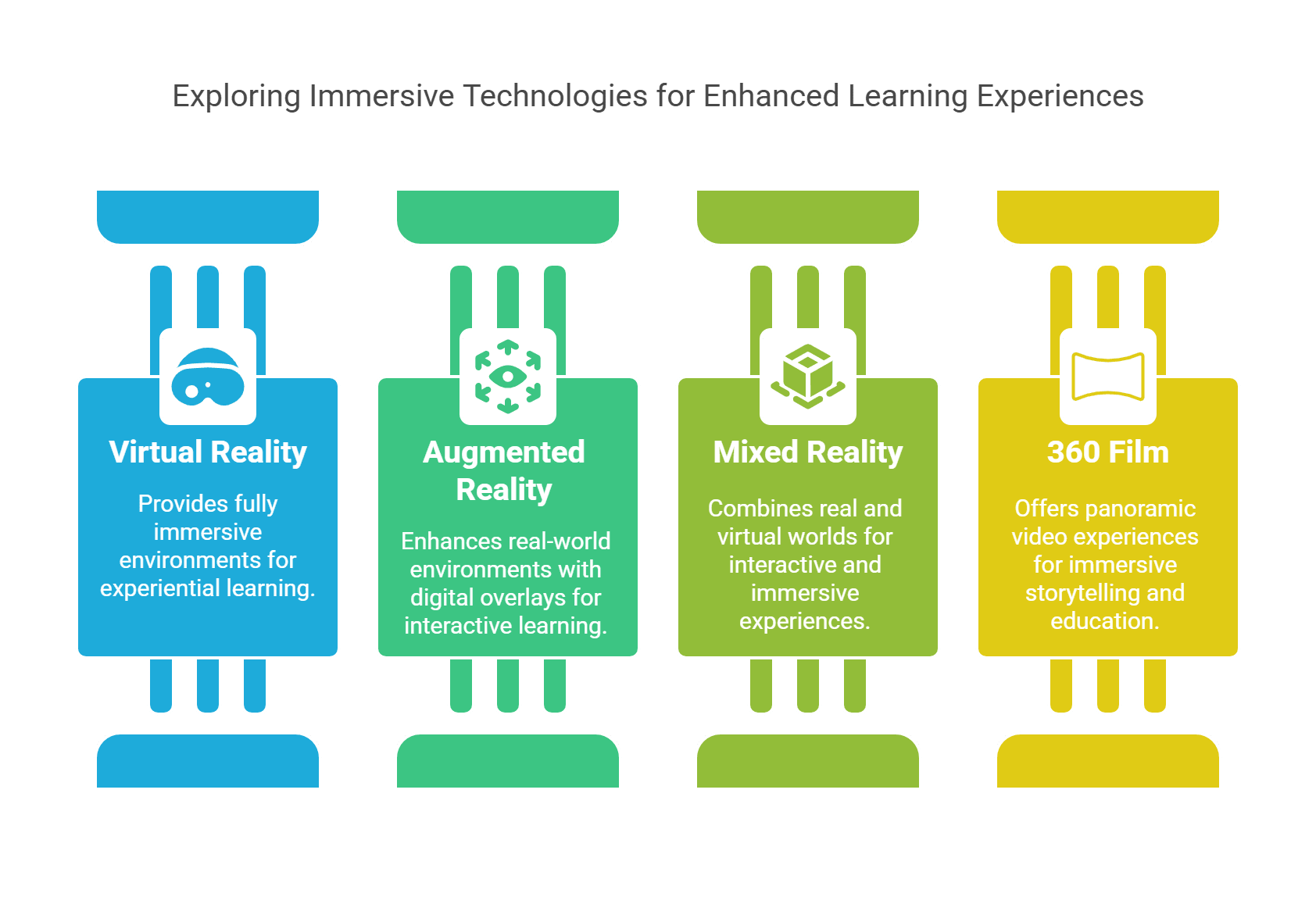
Four Types of Immersive Learning Experiences
Whether it’s immersive learning within traditional classrooms, hands-on vocational training, or informal yet engaging encounters like interactive museum displays, familiarizing oneself with diverse technologies marks the initial and essential phase for educators seeking to adopt immersive or blended learning methods.
Each variant of immersive educational technology offers distinct advantages that can be effectively incorporated into various educational settings. These include the following:
1. Virtual Reality
Virtual reality (VR) is one of the most useful technologies to support blended learning, as it enables fully immersive experiences.
Accessible through VR headsets, this experience is often enhanced with headphones and hand controllers, empowering learners to navigate and interact within their virtual environment.
2. Augmented Reality
In contrast to isolating the real world, augmented reality (AR) seamlessly integrates it with digital content. The digital elements can vary, ranging from flat and 2D, ideal for instructional information, to more intricate and lifelike in 3D. Activation of content can be linked to specific objects or geographical locations.
Accessible through mobile devices like smartphones and tablets, learners can easily engage with the content.
3. Mixed Reality
Mixed reality integrates features of both virtual and augmented reality. Like augmented reality, mixed reality overlays digital content onto the real-world environment, connecting and interacting with real-world objects.
A notable distinction lies in the fact that in mixed reality, digital assets can be visibly obscured by real-world objects.
4. 360 Film
360-degree video is typically captured live rather than generated by a computer. While you can experience this content through a VR headset, immersing yourself in the environment, the learner remains tethered to the filmmaker’s viewpoint.
This allows the learner to move their head for a panoramic view, but full interactivity is limited, as they cannot independently walk around or engage with their surroundings.
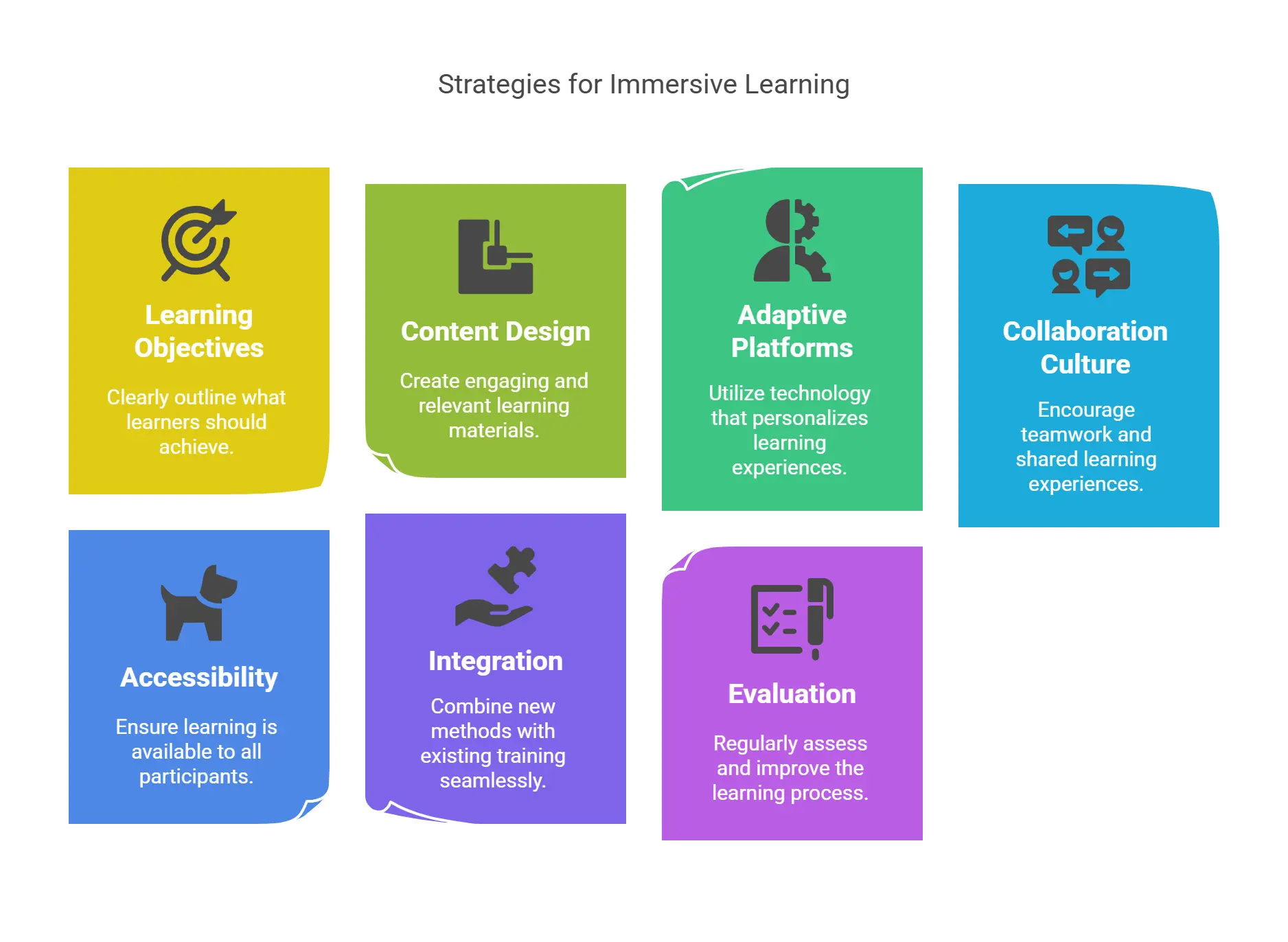
Seven Strategies for Creating an Immersive Learning Environment
Like any other form of education or training, immersive learning in education aims to expand a learner’s knowledge base and equip them with new skills.
By adopting immersive learning technologies, educators take the learner’s educational experience to the next level; however, successful implementation can often be challenging.
To navigate this process of introducing immersive educational technologies into their education and training programs effectively, educators can follow certain key teaching strategies, including;
1. Define Learning Objectives
For each immersive learning experience, clearly define the specific learning goals. Determine the exact skills, knowledge, or behaviors that you aim for your students to develop through the program.
Setting clear, targeted objectives ensures that the immersive learning experiences are purposefully aligned with the overall objectives of your organization, providing a focused and guided approach.
2. Immersive Content Design
Create exceptional content specifically designed for immersive learning experiences. Develop engaging scenarios, simulations, or activities that incorporate gamification principles, enabling students to practically apply their knowledge and skills.
Utilize storytelling methods and interactive features to boost learner engagement and memory retention. Continuously update and refine the content to maintain its relevance and to meet the evolving needs of the learners effectively.
3. Use Adaptive Learning Platforms
Adaptive learning platforms are becoming more and more popular across industries, especially in educational technology.
These platforms are pretty cool – they can answer whatever questions users throw at them and figure out how well they’re getting the hang of the material. And with this data, they modify the user’s experience, paving the way for personalized learning.
4. Foster a Culture of Collaboration and Learning
Promote teamwork, knowledge exchange, and learning from peers in the immersive learning environment. Give your students the freedom to share their perspectives, talk about their experiences, and learn from one another.
So cultivate an environment of ongoing learning and development where students feel encouraged to explore, experiment, and actively participate in the immersive-cum-experiential learning community.
5. Make it More Accessible
Incorporate learning on the go and the ability to learn anytime, anywhere into a responsive learning design. Utilize microlearning interventions, just-in-time learning, and on-the-job learning tools as integral components of your immersive learning environment.
Furthermore, make sure the platform is compatible with assistive technology and is available in different formats so that students with visual and hearing impairments can access the subject matter with ease.
6. Seamless Integration with Existing Training Programs
Identify opportunities where immersive learning can support or enrich traditional training methods. Integrating immersive learning into the mix with traditional classroom teaching, online courses, or on-the-job training gives you a well-rounded educational experience.
7. Continuous Evaluation and Feedback
Put in place an evaluation and feedback system to monitor the success of the immersive learning experiences regularly. Get input from students to learn about their opinions, difficulties, and recommendations for development.
To evaluate the effect of immersive learning on staff development and organizational objectives, track learning outcomes, knowledge retention, and performance metrics. Make educated changes and improvements to the interactive learning environment with the use of this data.
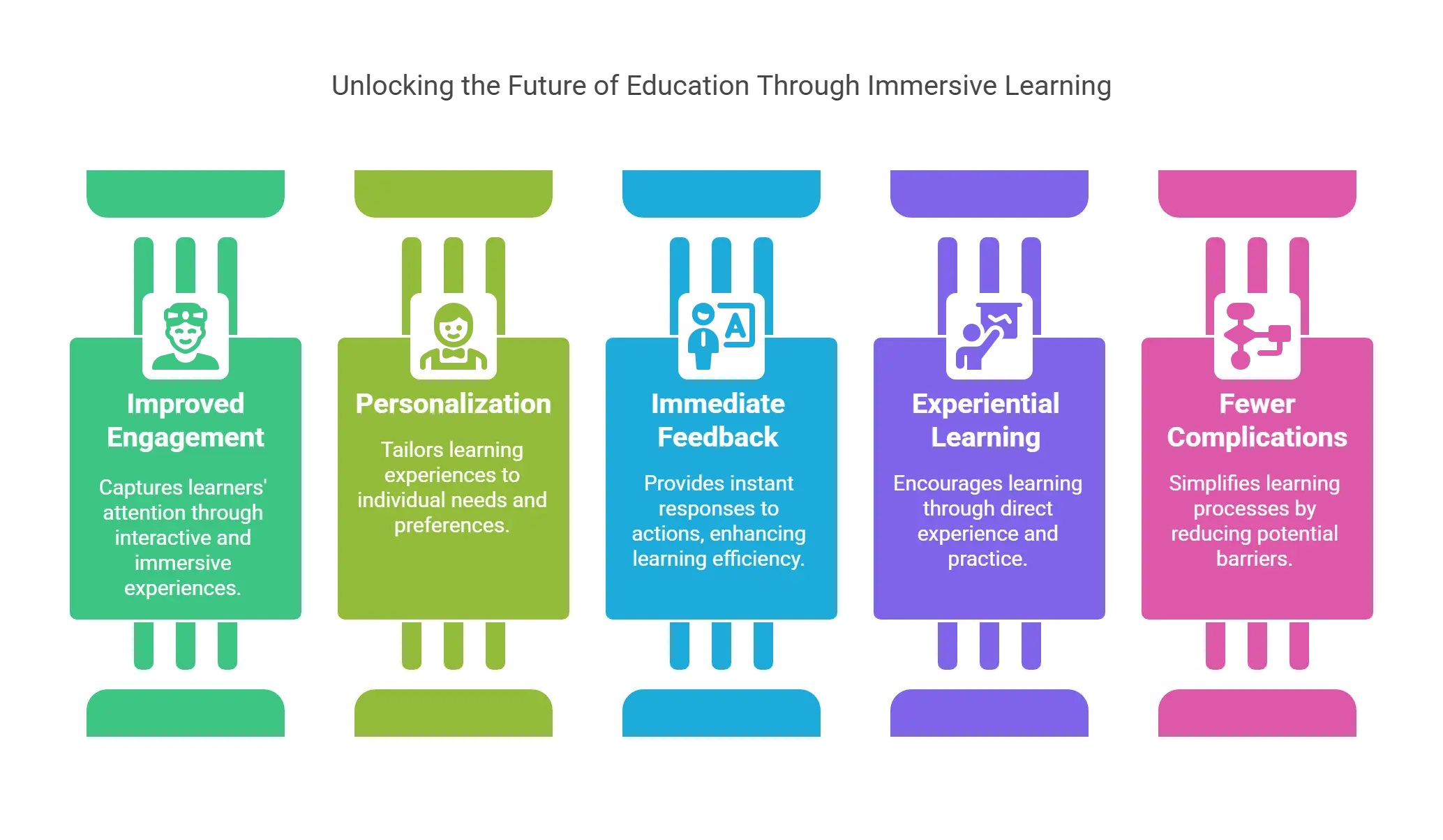
What are the Benefits of Immersive Learning?
Immersive learning platforms provide not only the benefit of efficacy in course delivery but several others to both educators and students:
1. Improved Engagement
The immersive learning curriculum is highly engaging because it stimulates more than a learner’s visual and aural attention. It stimulates interaction, decision-making, and action, leading to better engagement.
Students can engage more of their attention in devising solutions to the problems presented to them through immersive learning.
2. Personalization
Educators can tweak the learning program of each student according to their capacity for learning and content consumption preferences.
For example, for quick learners, educators can speed up or increase the difficulty of the course. On the other hand, for learners who face difficulties, educators can incorporate hints, tips, and tricks into the course.
Learners can also set the pace of their course
3. Immediate Feedback
The interactive modules are designed so that students receive immediate feedback on their performance for a particular task.
In case their problem-solving approach was correct but the solution was wrong, they will get prompt feedback to try again. Similarly, feedback can incorporate rewards for those who have performed well on a task.
4. Experiential Learning
Hands-on experiences while learning facilitate better recall and retention of the concepts taught during the lesson. This doesn’t necessarily have to be catered to through technology.
Incorporating interactive games based on educational concepts also classifies as experiential learning. A good example is teaching mathematical fractions through the use of pie models.
5. Fewer Complications
Using technology to create immersive learning experiences helps offset the steady cost of hiring the right educators and investing in printed resources.
It also removes the biases that some teachers develop towards the students who perform better, giving each learner an equitable opportunity to improve themselves through self-pacing and personalizing their course as per their needs.
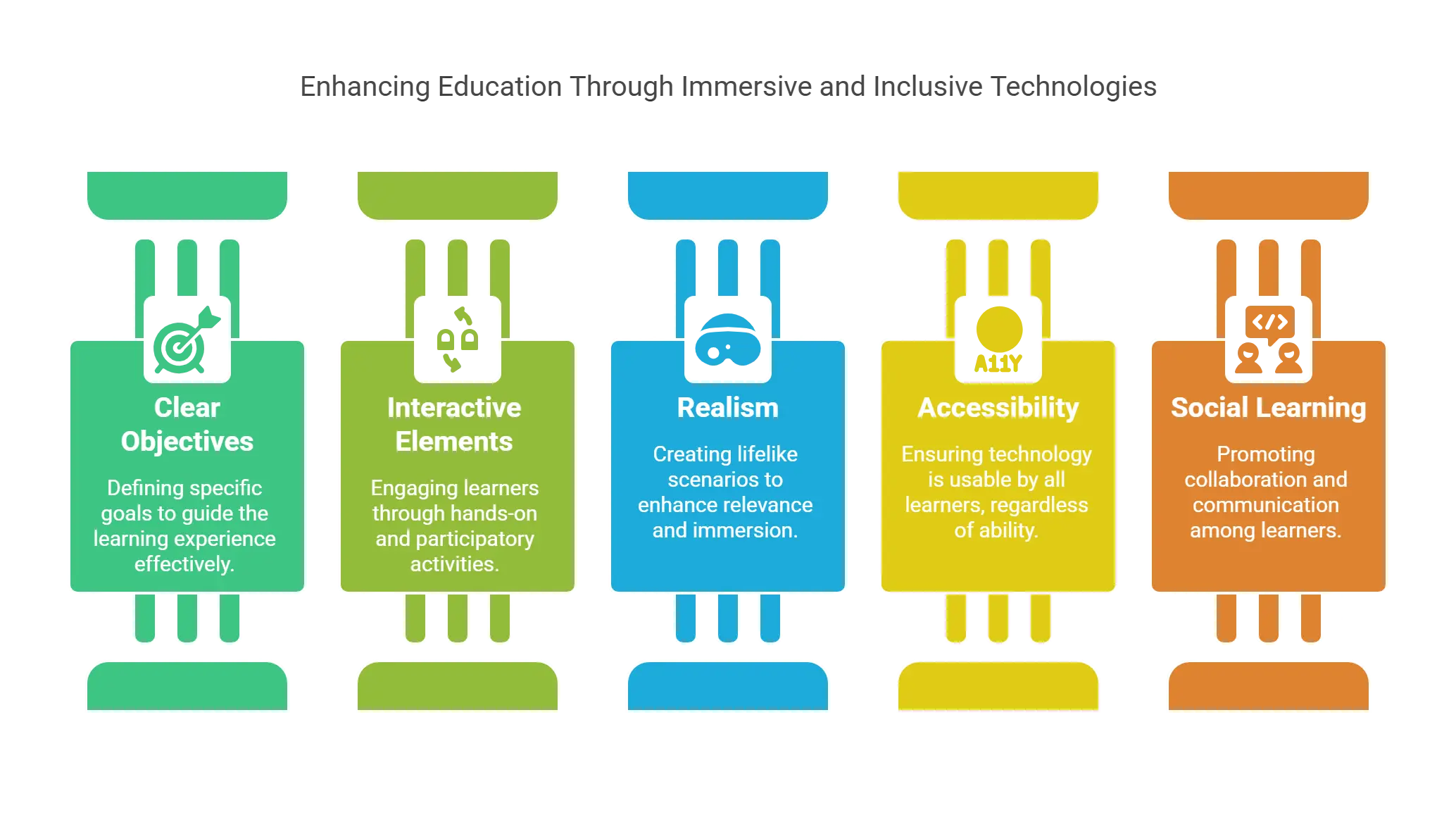
Best Practices For Immersive Learning Technologies
Immersive learning experiences deliver the right outcomes when they have been configured well to resonate with the objectives of the curriculum, the educators, and the learners.Here are a few best practices to keep in mind:
1. Clear Objectives
You gain the maximum benefit of immersive learning technologies when the goals of the modules are clearly defined. The learners should know exactly what is expected from them. Additionally, the module should be aligned well with the course objectives.
2. Interactive Elements
The inclusion of interactive elements, such as gamified assessments, videos, podcasts, etc., helps to make immersive learning more experiential.
They also augment the simulations and simulations that the immersive learning platform creates, which helps better the delivery of the lesson.
3. Realism
Immersive learning technologies can create hyper-realistic simulations of real-world scenarios to help enhance learning. Incorporating this in your lessons may help better deliver your students’ problem-solving or analytical capabilities.
4. Accessibility
Accessibility is the key to creating a successful course. You should ensure that the learning material you have created is accessible on all operating systems and is friendly with various devices.
5. Social Learning
Including ways for the learners to interact with each other during class helps knowledge sharing. It is a good decision to provide chat forums, collaborative learning modules, and peer review tasks to encourage social learning.
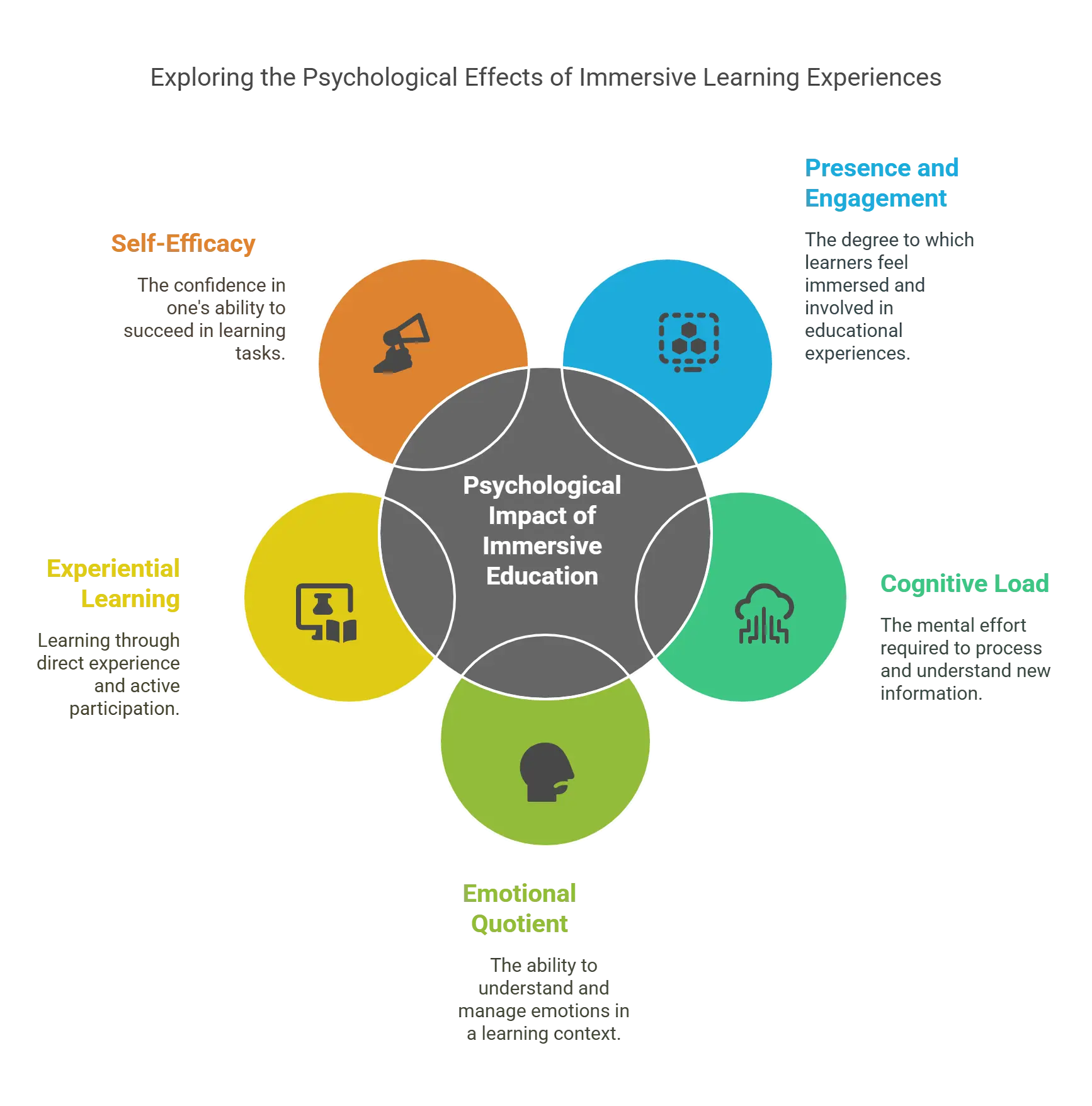
What is the Psychological Impact of Immersive Education on Learning?
All these cutting-edge immersive learning methods also have a significant and evident impact on the psychology of learning. The psychology of immersive education contributes directly to the benefits of learning and how virtual experiences affect learning.
Here are the five psychological impacts:
1. Presence and Engagement
Increased engagement and a psychological shift in presence are some of the most evident impacts of digital immersive technologies.
Immersing oneself in a VR environment, such as the Colosseum or a live historical war, skyrockets the levels of engagement. Virtually being there captivates a student’s attention, and the level of being present in such a surrounding has the potential to turn passive students into active explorers.
2. Cognitive Load
In traditional classroom education, learners often juggle multiple concepts to comprehend various processes. This often blocks up space in the mind.
With immersive education, a lot of this cognitive baggage can be offloaded. Its interactive and visual aspects help free up mental space for a more robust understanding of concepts.
Immersive education also shows changes in physiological behavior. While the benefits are that it helps develop muscle memory for performing tasks, the challenges would be tackling fatigue and stress levels.
To tackle its challenges, immersive education must be developed and delivered at an appropriate pace with the help of experts like Hurix Digital.
3. Emotional Quotient
With immersive learning, learning modules bring reality to the phrase “walking in another’s shoes.” Virtual experiences can also promote empathy and social-emotional learning (SEL).
For example, navigating virtual conflicts or experiencing historical injustices firsthand builds sensitivity and emotional quotient.
4. Experiential Learning
The traditional practice of learning by doing has always been beneficial in expediting learning experiences, but using the concept with immersive education takes it to new heights.
The psychological impact of being able to experiment in a safe, virtual environment fosters a “try and fail” ethos. Growing past missteps allows learners to build experience and confidence faster.
5. Self-Efficacy
Practicing complicated procedures broadens horizons and relieves a learner of self-limitations.
Especially for students from remote cities or with financial limitations, immersive learning methods can help their self-esteem, motivate their will to learn, and help them grow out of their mindsets. The feeling of self-efficacy is a profound psychological impact of immersive learning.
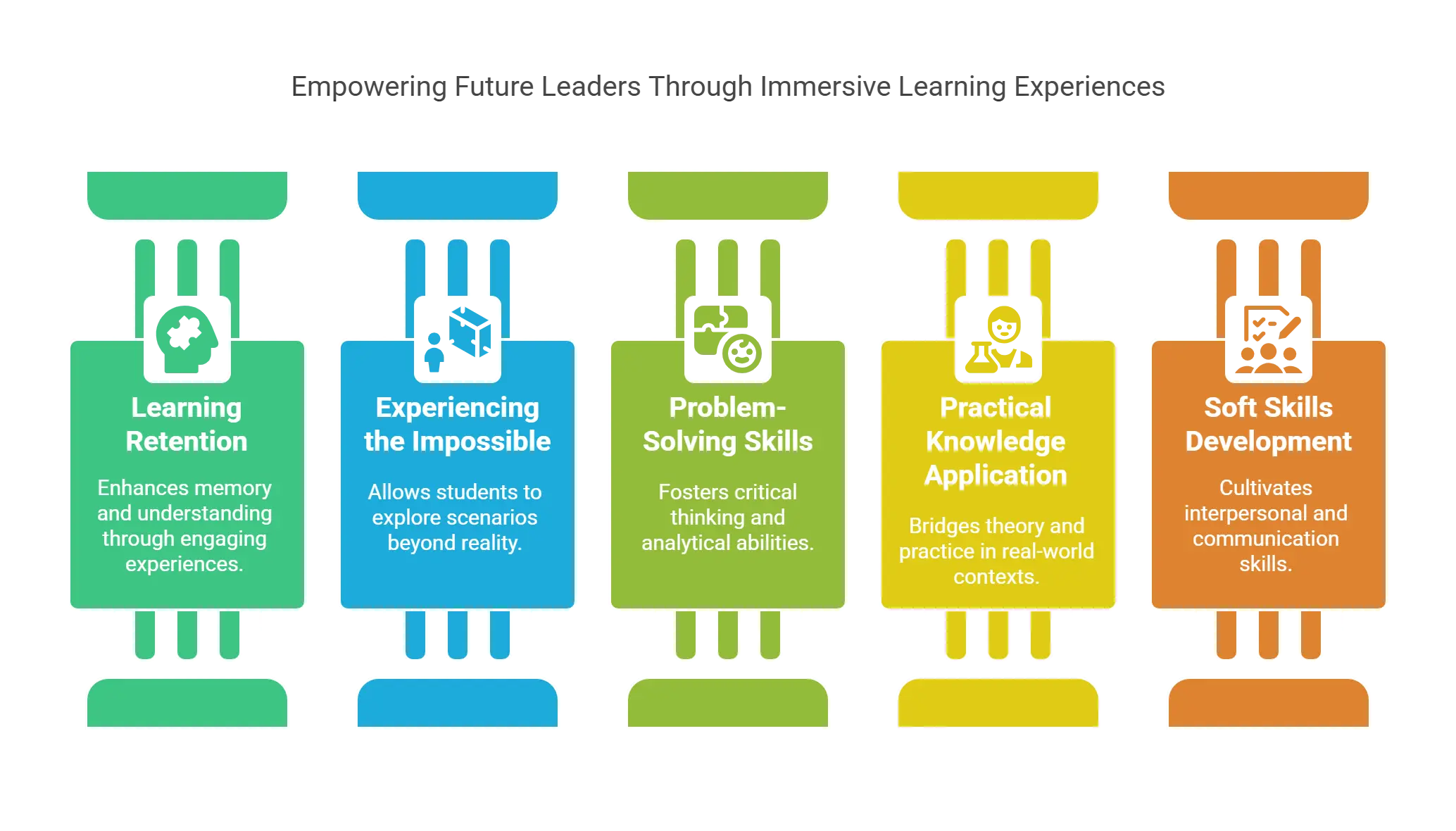
In this section, we take a quick look at the various benefits of immersive learning in education and how it can help enhance your curriculum and prepare students for their future.
However, before we do so, we’ll take you through the various types of technologies that can offer an immersive learning experience.
Now, let’s dive into the benefits of immersive learning.
1. It Improves Learning Retention
Immersive learning has the potential to improve information retention among students. In fact, a study shows that VR as a form of immersive learning can help students recall information correctly by 75%.
This goes to show the extent to which immersive learning technologies can help students retain information for longer and more accurately than they would via traditional rote learning methods.
Additionally, immersive learning also helps prepare students for the future by giving them practical exposure to a host of concepts that they’d otherwise only read about. As a result, when immersive learning modules are incorporated into the curriculum planning process, they can help teachers and students meet their learning objectives better.
2. It Helps Students Experience the Impossible
While field trips can be great resources to help offer experiential learning, they tend to have their limitations. These could be due to budgets or simply because certain experiences are simply too dangerous or impossible to experience.
In situations like these, immersive learning technologies like VR can come in handy when incorporated into curriculums. For example, if you’re teaching a course on marine biology and you think it would help to have your students witness how the ecosystem in a coral reef works, doing so in practical terms could be challenging.
However, VR can help your students experience what the world underwater looks like, and how the various organisms in coral reefs contribute to a healthy ecosystem. As a result, including immersive learning in curriculums can go a long way in augmenting the benefits of experiential learning as it adds a practical element to the learning experience.
In fact, statistics show us that the market for VR in education will grow at a CAGR of 39.2%, from $11.8 billion in 2023 to $16.42 in 2024. This goes to show the extent to which this technology is already making an impact and that its use is expected to increase with time.
3. It Helps Students Develop Critical Problem-Solving Skills
Another key advantage of immersive learning that can help prepare students pursuing their K12 education for future roles is its ability to help improve their problem-solving skills. Every curriculum aims to imbibe critical problem-solving skills in students, but only some truly succeed, especially when done via traditional learning methodologies.
Traditional rote learning often relies on producing memorized answers to complicated questions or scenarios, thereby reducing the opportunity for students to think critically.
On the other hand, when students are presented with a scenario in an almost life-like context, they stand a better chance of learning how to navigate any practical challenges thrown at them. When incorporated into curriculum development, these problem-solving skills can be crucial when students find themselves in a competitive professional landscape.
4. It Facilitates the Practical Application of Knowledge
While this might seem rather similar to the previous point, it can be an entire point of discussion in itself. One of the key benefits of immersive learning methodologies is that they help instill practical knowledge in students’ minds rather than just theoretical information.
As a result, elements of immersive learning and gamified learning bridge the gap that individuals often face when they find themselves in a professional workplace, where the knowledge gained from books has little impact on their ability to apply concepts in real-life scenarios.
The practical experience gained from immersive learning enables students to seamlessly be more capable of finding practical solutions to problems, thereby keeping their contribution to their new environment.
5. It Can Help Develop Critical Soft Skills
Aside from all the benefits in terms of developing hard or technical skills, immersive learning and technologies like AI can also help students develop a more global perspective and become empathetic human beings.
Unlike the past, when students were limited to viewpoints, histories, and perspectives from their immediate environment, technology today can help transport students anywhere in the world, allowing them greater exposure to different cultures, traditions, identities, and more.
This exposure, in turn, can help them grow into globally competitive and aware individuals while also developing key skills like empathy.
In Conclusion
Immersive learning is one of the most impactful technologies in the world of education today, and its use is only expected to increase with time. Incorporating elements of immersive learning in student curriculums offers a host of benefits, strengthening their foundations for the future.
From improving learning retention to building critical problem-solving skills, the list of these benefits is endless. These benefits demonstrate the extent to which the use of such immersive learning technologies is set to increase in the future.
If you’re an educational institute that’s looking to capitalize on the benefits of this changing landscape, reach out to like digital curriculum providers Hurix Digital and experience their eLearning and training solutions today!

Senior Vice President
A Business Development professional with >20 years of experience with strong capability to sell new solutions and develop new markets from scratch. New Market Entry Specialist with experience of working in two of the largest emerging markets – China & India. Also covered other key markets in APAC, US, EU & ME. Exceptional experience of conceptualizing, ideating and selling new learning technologies like VR AR, etc. across multiple industry verticals.
